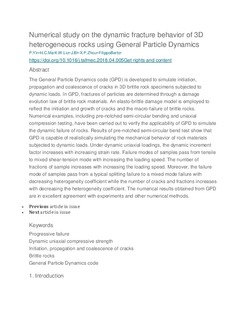| dc.contributor.author | Yin, P | |
| dc.contributor.author | Ma, HC | |
| dc.contributor.author | Liu, X.W. | |
| dc.contributor.author | Bi, J. | |
| dc.contributor.author | Zhou, X.P. | |
| dc.contributor.author | Berto, Filippo | |
| dc.date.accessioned | 2019-02-26T13:43:37Z | |
| dc.date.available | 2019-02-26T13:43:37Z | |
| dc.date.created | 2018-11-26T10:56:22Z | |
| dc.date.issued | 2018 | |
| dc.identifier.citation | Theoretical and applied fracture mechanics (Print). 2018, 96 90-104. | nb_NO |
| dc.identifier.issn | 0167-8442 | |
| dc.identifier.uri | http://hdl.handle.net/11250/2587548 | |
| dc.description.abstract | The General Particle Dynamics code (GPD) is developed to simulate initiation, propagation and coalescence of cracks in 3D brittle rock specimens subjected to dynamic loads. In GPD, fractures of particles are determined through a damage evolution law of brittle rock materials. An elasto-brittle damage model is employed to reflect the initiation and growth of cracks and the macro-failure of brittle rocks. Numerical examples, including pre-notched semi-circular bending and uniaxial compression testing, have been carried out to verify the applicability of GPD to simulate the dynamic failure of rocks. Results of pre-notched semi-circular bend test show that GPD is capable of realistically simulating the mechanical behavior of rock materials subjected to dynamic loads. Under dynamic uniaxial loadings, the dynamic increment factor increases with increasing strain rate. Failure modes of samples pass from tensile to mixed shear-tension mode with increasing the loading speed. The number of fractions of sample increases with increasing the loading speed. Moreover, the failure mode of samples pass from a typical splitting failure to a mixed mode failure with decreasing heterogeneity coefficient while the number of cracks and fractions increases with decreasing the heterogeneity coefficient. The numerical results obtained from GPD are in excellent agreement with experiments and other numerical methods. | nb_NO |
| dc.language.iso | eng | nb_NO |
| dc.publisher | Elsevier | nb_NO |
| dc.rights | Attribution-NonCommercial-NoDerivatives 4.0 Internasjonal | * |
| dc.rights.uri | http://creativecommons.org/licenses/by-nc-nd/4.0/deed.no | * |
| dc.title | Numerical study on the dynamic fracture behavior of 3D heterogeneous rocks using General Particle Dynamics | nb_NO |
| dc.type | Journal article | nb_NO |
| dc.type | Peer reviewed | nb_NO |
| dc.description.version | acceptedVersion | nb_NO |
| dc.source.pagenumber | 90-104 | nb_NO |
| dc.source.volume | 96 | nb_NO |
| dc.source.journal | Theoretical and applied fracture mechanics (Print) | nb_NO |
| dc.identifier.doi | 10.1016/j.tafmec.2018.04.005 | |
| dc.identifier.cristin | 1634939 | |
| dc.description.localcode | © 2018. This is the authors’ accepted and refereed manuscript to the article. Locked until 12.4.2020 due to copyright restrictions. This manuscript version is made available under the CC-BY-NC-ND 4.0 license http://creativecommons.org/licenses/by-nc-nd/4.0/ | nb_NO |
| cristin.unitcode | 194,64,92,0 | |
| cristin.unitname | Institutt for maskinteknikk og produksjon | |
| cristin.ispublished | true | |
| cristin.fulltext | postprint | |
| cristin.fulltext | preprint | |
| cristin.qualitycode | 1 | |

